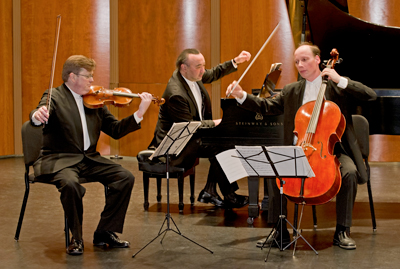by Daniel Hathaway

Thus a former string quartet has both downsized in numbers and broadened its instrumentation. The Montrose Piano Trio will play its Cleveland debut to open the 67th season of the Cleveland Chamber Music Series at Plymouth Church in Shaker Heights on Tuesday, September 27 at 7:30 pm. We reached cellist Clive Greensmith by telephone in his studio at the Colburn School in Los Angeles, where he and Martin Beaver co-direct the chamber music program, to talk about the new Trio and its program next week.
Daniel Hathaway: A cellist has a very different role in a piano trio than in a string quartet. Can you tell us how that transition feels for you?
Clive Greensmith: To put it in a very curt way, the major difference I think I’ve been noticing is that I get to play on the “A” string again. There’s a greater equality of voicing among the instruments, and it’s a very welcome chance to develop that part of my own playing — as well as having the excitement of being able to play with a wonderful pianist. And although the repertoire is from the same creative sources — Haydn, Schumann, Brahms — the medium is different, and to achieve the proper balance, the cellist needs to play in a slightly different way. That’s fascinating, and I love the way that I can work with Jackie to become an extension of his left hand when we’re playing early Beethoven. It’s a wonderful new challenge.
DH: And you can consider yourself lucky that you’re not the pianist in your middle piece, Beethoven’s Op. 1, No. 1.
CG: (Laughs) It’s a real piano concerto tour de force!
DH: You’re beginning your Cleveland program with Joaquín Turina’s Second Trio. That piece doesn’t pop up very often.
CG: You’re correct that it doesn’t get played very much, but there’s a lot to be said for the piece — and also for Turina. He’s a bit of an unsung hero in a way. He’s very prominent in that small but important Spanish part of the repertoire. The Second Trio is a mature piece from 1933, and you can certainly hear the influence of the time he spent with Ravel, Debussy, and Fauré in Paris. But there’s also a distinctly Spanish flavor to it — the melodic intervals, the chord progressions. And there’s that wonderful Scherzo in 5/8 time. He does his best, rather like César Franck or Debussy would have done, to tie the piece up by bringing themes back. It has an absolutely irresistible charm to it, as well as great depth. And invariably, it contrasts really well with anything else you put around it.
DH: You’re ending with Brahms’s First Trio, which he revised some 35 years after he wrote it. Have you had the opportunity to play both versions?
CG: That’s something we discussed. It seems to be more in vogue again for groups to perform the original version. I can see why. And it’s interesting that Brahms never destroyed the earlier version. He left it in print, which says something about the fact that the early version does have its own merits. But there’s no denying that what you get in the second version is more concise and more tightly organized — which is one of the things that we all love about Brahms. But I also love the early version because it’s so daring and he lets the fantasy part of his craft take flight. It would be fun one day to play both versions in the same evening!
There’s that wonderful quote from Richard Specht about the first version where he describes the piece as “the whole twenty-year-old composer with all his inner stress, his fullness of heart, his ardent longing; all the apprehension, pride, restraint, and expectation of a soul in flower.” At the time, Brahms had just met the Schumanns, so the first version is incredibly important. But we will be playing the second version in Cleveland, which is one of the most satisfying pieces in the repertoire. The progression from one movement to another is just breathtaking, and the last movement is absolutely wondrous and incredibly exciting.
DH: You and Martin see each other all the time at the Colburn School, but how often are you able to get together as a trio?
CG: We’ve been very fortunate. In our first season, we had at least 25 concerts, and we’ve been working together over the summer. We played our first Schubert B-flat Trio for the La Jolla Music Society in August, and we played at the International Chamber Music Festival in Hong Kong last year. We always take time in advance to meet up either in Houston or Los Angeles, or we’ll arrive early somewhere to rehearse. Martin and I are constantly working together, so we’re able to resolve important string issues between the two of us. We’re building on a fifteen-year relationship that included eleven years with the quartet, so it’s that much easier to put pieces together on relatively short notice.
DH: We’re really looking forward to the Trio’s Cleveland debut.
CG: Cleveland is one of the most sophisticated and enthusiastic of audiences. We’re very excited to be playing there again.
Published on ClevelandClassical.com September 20, 2016.
Click here for a printable copy of this article



